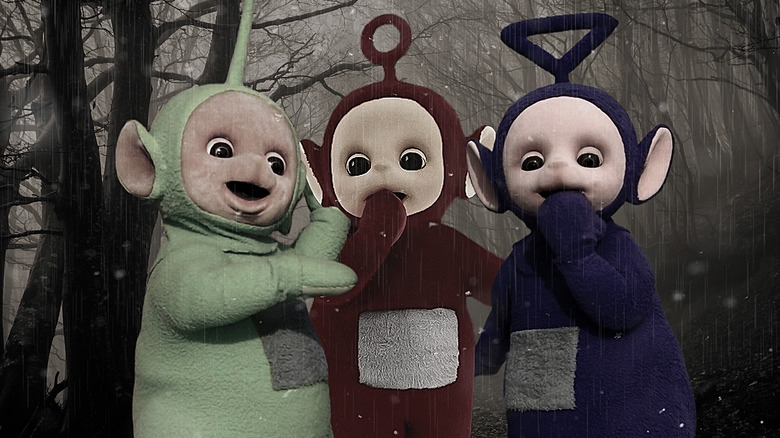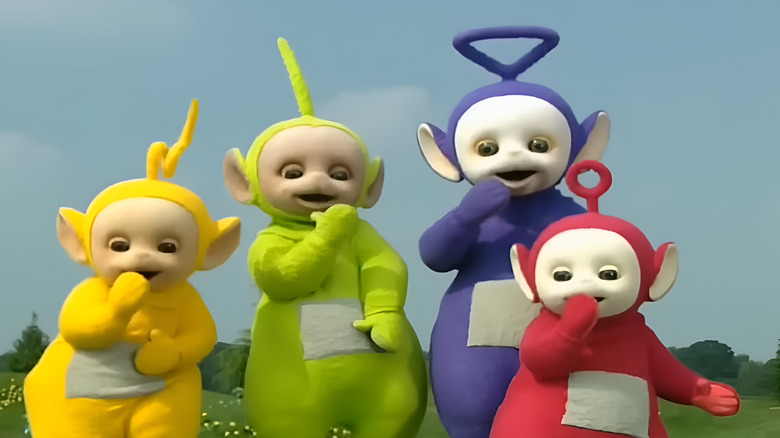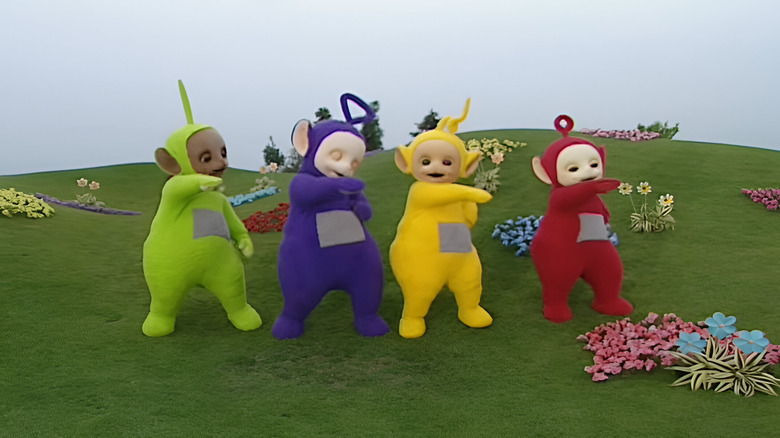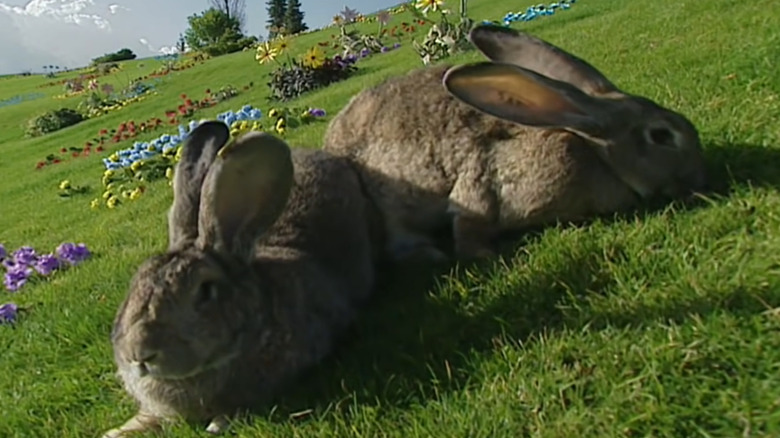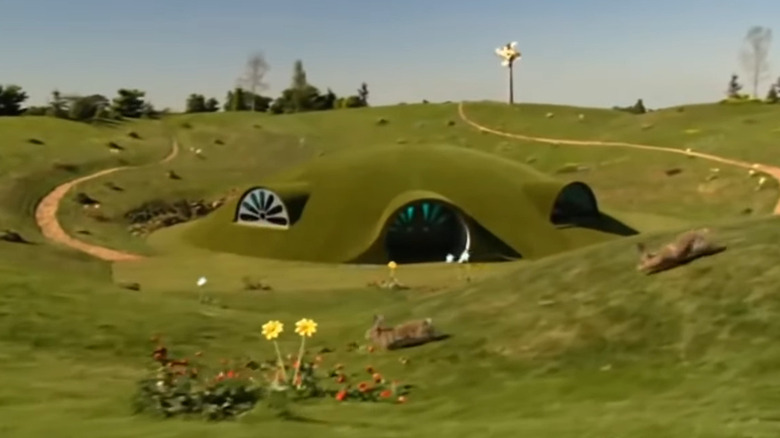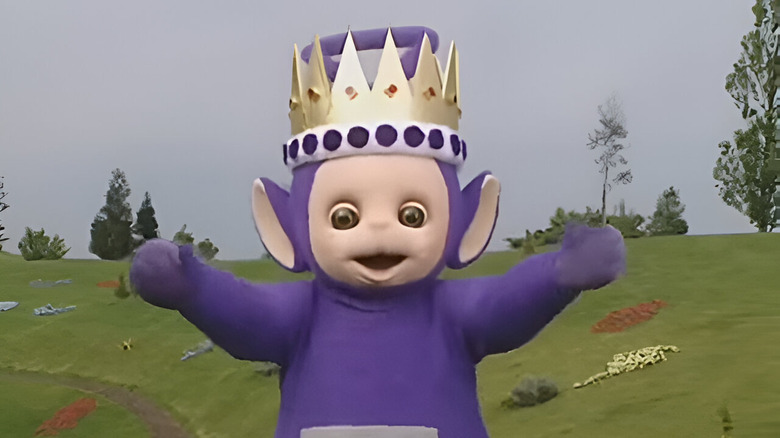5 Dark Teletubbies Facts That May Crush Your Childhood
The following article includes topics of addiction, allegations of sexual assault, and death.
Like most live-action children's media, the BBC's "Teletubbies" is entertainment for younger audiences performed by adult artists. That means that the onscreen antics get to stay bubbly and magical, but the offscreen reality is sometimes a little, well, different, though it's not always bad per se. Consider, for example, how the starring cast of "The Wiggles" tends to hide literal tattoo sleeves under their modest turtle necks. Other times, though, the behind-the-scenes secrets are closer to the since-cleared sexual assault allegations that haunted "Sesame Street" in 2014. There's a spectrum, is what we're saying.
Don't worry, nothing quite so sinister is happening with "Teletubbies." Still, there are enough stories about the original 1997-2001 run (although some of it probably applies to the 2015-2018 revival as well) to scar your pristine mental image of Tink Winky, Dipsy, Laa-Laa, and Po. What? You don't have a pristine image of the show's mysterious aliens with televisions housed in their tummies? Are those soulless eyes failing to spark joy? Wait, no, it's the vacuum thing, isn't it? Whatever the reason, it's fair. Co-creators Anne Wood and Andrew Davenport have a lot to answer for ... like how they made their cuddly astronaut babies literal giants.
Wait, how tall are the Teletubbies, again?
That's right, folks, we're kicking things off with possibly the most well-circulated piece of wretched Teletubby trivia. You'd be forgiven for assuming that the four color-coded nightmares are average-sized, or perhaps even small — the Teletubbies are infants, after all, infants that live inside of a hollow hill. From a certain viewpoint, they're gurgling space Hobbits. How big could they really be? Well, the answer is big. They're really, really big. The Teletubbies are smiling, towering monsters, with the shortest among them, Po (who is played by two incredible women), standing at an incomprehensible six feet and seven inches. Remember, she's the short one; Dipsy and Laa-Laa both stand at seven feet, and Tinky Winky is a staggering seven feet and eleven inches.
Let that sink in. The shortest Teletubby is taller than the average NBA player. Shaquille O'Neal can almost match their eyeline, but that's about it. Look, it makes sense that they're gargantuan because the Teletubbies are essentially glorified mascot costumes and normal human beings have to fit inside them somehow ... but reason isn't winning out here. Back in 2017, just after a 2001 Time article resurfaced, The Sun rounded up a few internet responses, and the public consensus boiled down to, "Thanks! I hate it."
Don't like sweating? Don't audition to be a Teletubby
When discussing the Telletubbies' true size, you have to accept that if it means the actors inside the suits have enough room to do their jobs, then so be it. But that leads to another problem, though. Something that big must weigh a ton, and the Teletubbies are not stationary creatures. Can you imagine running and jumping and dancing in one of those things? It would be torture ... smelly, sweaty torture.
Original Dipsy talent John Simmit confirmed as much in a 2021 interview with the Huffington Post. After describing how strenuous a workout performing on "Teletubbies" was, he said, "We had to wear really ugly underwear like those old Western long johns ... [we wore them to] absorb the sweat. When we were out of costume, you'd have to turn your face the other way and speak to us at a distance because we were reeking and so sweaty you could wring us out."
Granted, Simmit likely had it worse off than the others because he made Dipsy dance every chance he got, but he didn't say "wring me out," he said "wring us out," which means that every single actor was sloshing around in a pool of their own sweat during the filming process. Doesn't seem like a mess Noo-Noo is equipped to handle, does it?
The Teletubbies set doubled as a hot spot for bunny lovin'
The Teletubbies, their weird sentient vacuum thing, and the sun baby aren't the only creatures that inhabit the BBC's bizarre television program. For whatever reason, the set was crawling with rabbits. Flemish giant rabbits, specifically. During that same 2021 interview with the Huffington Post, John Simmit speculated, "I think that was [Anne Wood's] way of changing the perspective and making us look small." If Simmit's theory is correct, then Wood accomplished her goal because no one knew the Teletubbies were secretly Kaiju until that Time article dropped back in 2001. But Wood's attempt at camouflage came with a price, one that children's media cannot afford to pay.
According to the "Teletubbies" fan wiki, the Flemish giant rabbits were neither spayed nor neutered, which means that they heeded nature's call. Apparently, the crew was forced to reshoot several scenes because the cameras accidentally caught some of the critters mating. As far as trivia goes, this is less dark than it is hilarious, but it probably scared the crew enough to earn a more somber adjective. Imagine desperately scanning every set for fear of excitable rabbits. Maybe the editors even did an extra pass over the footage just to check for potential offensive content. Nothing guarantees the end of a syndicated run quite like exposing these visuals to children before their parents are ready for the talk, right?
A farmer flooded the original Teletubbies set to ward off tourists
For most of us, avoiding unwanted house guests is as easy as not answering the phone or doorbell. For Rosemary Harding, though, it wasn't that simple because she owned the land where "Teletubbies" once filmed. Despite the BBC removing the set when production wrapped in 2001, fans would flock to the location just to get a glimpse of the famous grassy hill. It's important to note that the area was not open to the public, which means that every single visitor was trespassing on private property just to see a whole lot of nothing. Perhaps understandably, this frustrated Harding. And so, in 2013, she solved her problem with a bulldozer and a few metric tons of water.
Where the Tubbytronic Superdrome — no, seriously, that's what it's called — once stood, there is now a lovely pond. Fortunately for Harding, the construction project successfully warded off unwanted attention. No longer are tourists plaguing the countryside. Unfortunately for everyone else, though, Harding's solution wiped a beloved piece of film history off the map. Since the "Teletubbies" revival series ran from 2015 to 2018, Harding either drowned the hill just before the BBC could reach out about potentially using it again or as a direct response to the request.
Tinky Winky actor Simon Shelton died a tragic death
Although not directly causal, actors suffer from addiction at a higher rate than most other professions. In 2018, Tinky Winky talent Simon Shelton, also known as Simon Barnes, died from a combination of hypothermia and alcohol. According to Sky News, coroner Anita Bhardwaj ruled his death a misadventure, elaborating in her report that Shelton, whose medical history of alcohol dependence was well-documented, was found outside the Port of Liverpool Building in the early hours of January 17, 2018, with a high concentration of alcohol in his system. The temperature was noted to be three degrees Celsius, or 37 degrees Fahrenheit. Shelton was 52 when he died.
Shelton is not the original Tinky Winky actor. Dave Thompson holds that honor, though he was fired after a year of working on "Teletubbies." Shelton, a trained ballet dancer, replaced Thompson and remained with the BBC production until the original run ended in 2001. Throughout his tenure with the show, Shelton faced accusations that he was peddling pro-LGTBQIA+ messages to children because three-year-old Tinky Winky sometimes carried a purse. It must not have affected him too deeply because News also noted that Shelton spoke in 2008, saying, "I didn't know it would be as big as it was, but I did know as soon as I started working on ['Teletubbies'] that it had something special."
If you or anyone you know needs help with addiction issues, help is available. Visit the Substance Abuse and Mental Health Services Administration website or contact SAMHSA's National Helpline at 1-800-662-HELP (4357).
